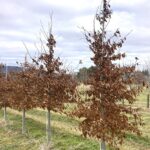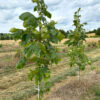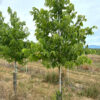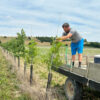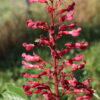Quercus alba, the white oak, is a large, commercially important tree indigenous to the eastern half of the United States. The namesake of the white oak subfamily (Quercus sect. Quercus), its range extends from southern Maine westward to the southern third of Minnesota and southward to near the Gulf coast.
The white oak inhabits a wide range of habitats within its native range, thriving in a range of soil types excluding regularly-saturated situations and thin rocky soils. It is a common tree on the west slopes of the Appalachians and Alleghany and Cumberland Plateaus, but typically is a scrubby shrub at higher elevations. As an isolated tree away from competition, Quercus alba matures to a massive, broad specimen, often over 30 m (100 ft) in height and an equal or greater branch spread. In a forest setting, the tree can become over 50 m (165 ft) tall. The record size for white oak is held by the Mingo Oak, an old-growth tree in Mingo County, WV which died in 1938 and was felled in the autumn of that same year. It was recorded at over 60 m (200 ft) in height with a branch-free trunk of 45 m (145 ft) and a circumference of 9.4 m (just under 31 ft). Its age was estimated at 582 years. Many other white oak trees have documented ages of 200-400 years.
[Article continues below photos.]
White oak is relatively slow-growing. In youth, the bark is a smooth pale grey, becoming furrowed with age while retaining the same color. The leaves emerge in mid-spring along with the flowering catkins; the leaves are initially reddish-pink giving a frosty appearance. The budding leaves become yellow-green then a glossy medium green, oval in shape with 7 to 9 rounded lobes. Autumn color is typically a deep red; the dried brown leaves often persist on younger trees through most of the winter. The tree does not typically bear acorns until 20-25 years of age, and then sparingly until the tree is fifty or more years old. Fallen acorns experience no dormancy and will sprout easily; they are less tannic and bitter than most other native Quercus species and as such are a favorite wildlife food, including turkeys, ducks, pheasants, rabbits, squirrels, and deer.
Commercially, white oak wood is dense and extremely rot-resistant. It is valued for flooring and shipbuilding and the unique ray and fleck pattern of quarter-sawn white oak wood has long been a favorite of furniture makers. Due to its resistance to liquids, white oaks is in demand for staves for wine and whiskey around the globe.
In the landscape, Quercus alba is best reserved for larger areas due to its size and spread. It is generally too large for smaller properties and unsuited for street-tree installations due to its taproot and dislike of urban pollution. But given space, it thrives, providing great summer shade, wildlife food, and a legacy for future generations due to its long life.
White House Natives currently supplies Quercus alba in sizes from 1½” to 3” caliper. It is a classic and dignified choice that stands the test of time.


